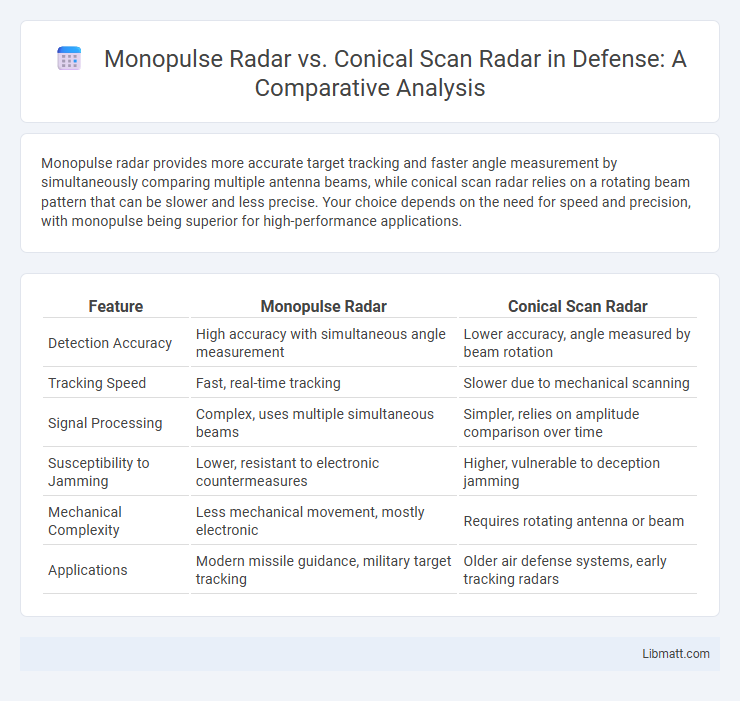Monopulse radar provides more accurate target tracking and faster angle measurement by simultaneously comparing multiple antenna beams, while conical scan radar relies on a rotating beam pattern that can be slower and less precise. Your choice depends on the need for speed and precision, with monopulse being superior for high-performance applications.
Table of Comparison
| Feature | Monopulse Radar | Conical Scan Radar |
|---|---|---|
| Detection Accuracy | High accuracy with simultaneous angle measurement | Lower accuracy, angle measured by beam rotation |
| Tracking Speed | Fast, real-time tracking | Slower due to mechanical scanning |
| Signal Processing | Complex, uses multiple simultaneous beams | Simpler, relies on amplitude comparison over time |
| Susceptibility to Jamming | Lower, resistant to electronic countermeasures | Higher, vulnerable to deception jamming |
| Mechanical Complexity | Less mechanical movement, mostly electronic | Requires rotating antenna or beam |
| Applications | Modern missile guidance, military target tracking | Older air defense systems, early tracking radars |
Introduction to Radar Tracking Technologies
Monopulse radar offers superior target tracking accuracy by simultaneously comparing signals from multiple antenna beams, enabling precise angle measurement with minimal error caused by target fluctuation or signal noise. Conical scan radar relies on mechanically rotating a narrow beam around the target axis, producing angle error signals by analyzing amplitude variations, but it is more susceptible to errors from target scintillation and signal distortions. These fundamental differences make monopulse radar the preferred technology in modern high-precision tracking applications such as missile guidance and advanced air defense systems.
Overview of Monopulse Radar
Monopulse radar utilizes simultaneous comparison of signals received in multiple antenna beams to accurately determine the angle of a target, significantly improving tracking precision and reducing errors caused by signal fluctuations. Unlike conventional conical scan radar, which rotates a single beam to measure angles over time, monopulse radar processes received signals instantly, enabling rapid and reliable target direction measurement. Its ability to provide high angular accuracy and resistance to electronic countermeasures makes monopulse radar essential in modern military and surveillance applications.
Overview of Conical Scan Radar
Conical scan radar continuously rotates its radar beam around the target to maintain tracking accuracy by detecting signal amplitude variations. This technique allows for precise angle measurements essential in missile guidance and fire control systems. Your tracking system benefits from the conical scan's ability to provide smooth corrections in target positioning compared to monopulse radar's instantaneous angle measurement method.
Principle of Operation: Monopulse vs. Conical Scan
Monopulse radar operates by simultaneously comparing signals received in multiple antenna beams to determine target angle with high accuracy, providing instant and precise tracking. In contrast, conical scan radar rotates its beam in a small cone to detect target displacement through amplitude variations over time, resulting in slower and less accurate angular measurements. Understanding these principles allows you to select the optimal radar system for applications requiring rapid and precise target tracking.
Accuracy and Reliability Comparison
Monopulse radar offers superior accuracy and reliability compared to conical scan radar by simultaneously processing multiple signal beams to minimize errors caused by target movement or signal fluctuations. This technology enables precise angle measurement and faster response times, reducing the likelihood of signal misinterpretation common in conical scan systems that rely on signal amplitude variations over time. Your targeting and tracking performance significantly improves with monopulse radar's enhanced ability to maintain stability and lock-on even in challenging environments.
Response to Electronic Countermeasures
Monopulse radar offers superior resistance to electronic countermeasures by simultaneously comparing signals received in multiple beams, enabling accurate target tracking even under jamming conditions. Conical scan radar, relying on sequential signal comparisons, is more vulnerable to deception through amplitude or phase jamming techniques. You benefit from monopulse radar's enhanced reliability in contested electronic environments, ensuring consistent target detection and tracking performance.
Complexity and Cost Analysis
Monopulse radar systems exhibit higher complexity due to their simultaneous multidirectional signal processing, requiring advanced hardware and sophisticated signal processing algorithms. Conical scan radars use a simpler mechanical scanning method, leading to lower production and maintenance costs but potentially reduced accuracy and robustness against jamming. Evaluating your requirements for precision and budget will determine the best radar system investment.
Applications in Modern Defense Systems
Monopulse radar provides superior target tracking accuracy and resistance to jamming, making it essential for modern missile guidance and aircraft fire control systems. Conical scan radar, while historically significant for surface-to-air missile targeting, is gradually being replaced due to its vulnerability to electronic countermeasures and slower response times. Your defense systems benefit most from integrating monopulse radar technology to enhance precision and reliability in complex combat environments.
Advantages and Limitations
Monopulse radar provides greater accuracy and faster target tracking by measuring the angle error in a single pulse, reducing susceptibility to target scintillation and jamming. Conical scan radar offers continuous target tracking with simpler hardware but suffers from slower response times and vulnerability to angular errors caused by target fluctuations. Your choice depends on whether you prioritize rapid, precise tracking or cost-effective, continuous target monitoring.
Future Trends in Radar Tracking Methods
Monopulse radar technology is advancing with integration of adaptive signal processing and machine learning algorithms, enhancing real-time target discrimination and resistance to jamming. Conical scan radar is evolving through hybrid systems combining its continuous angle measurement with monopulse precision to improve tracking accuracy over cluttered environments. Future trends emphasize multi-sensor fusion and digital beamforming for both radar types, driving improvements in autonomous vehicle navigation and advanced defense systems.
Monopulse radar vs Conical scan radar Infographic

 libmatt.com
libmatt.com